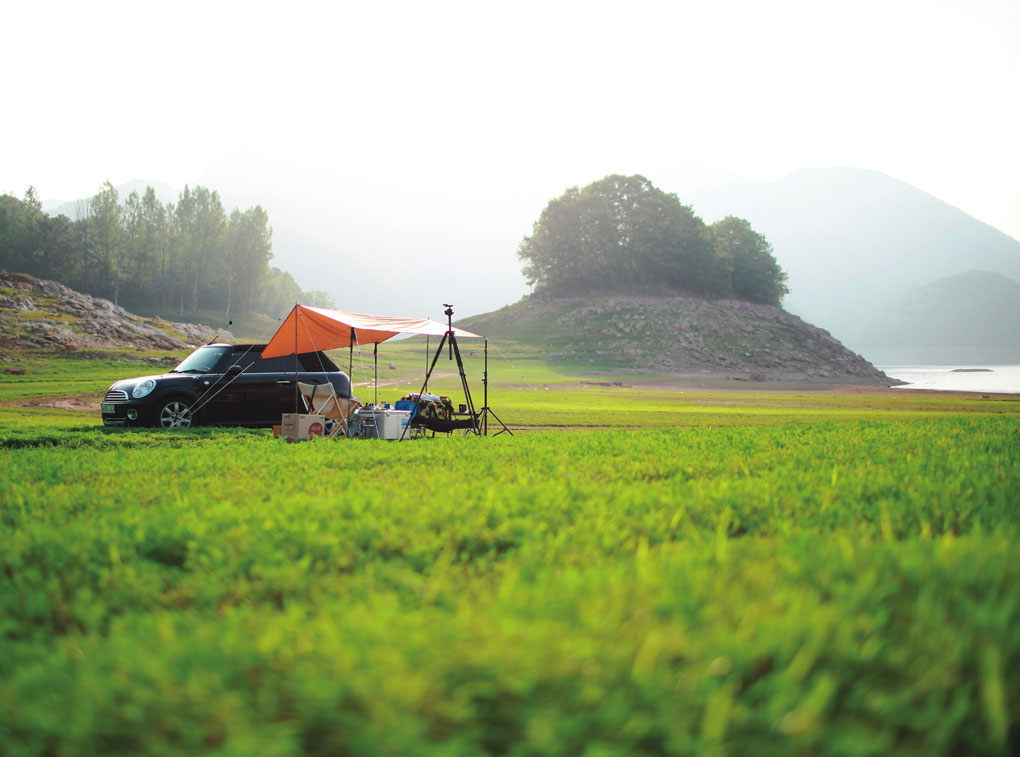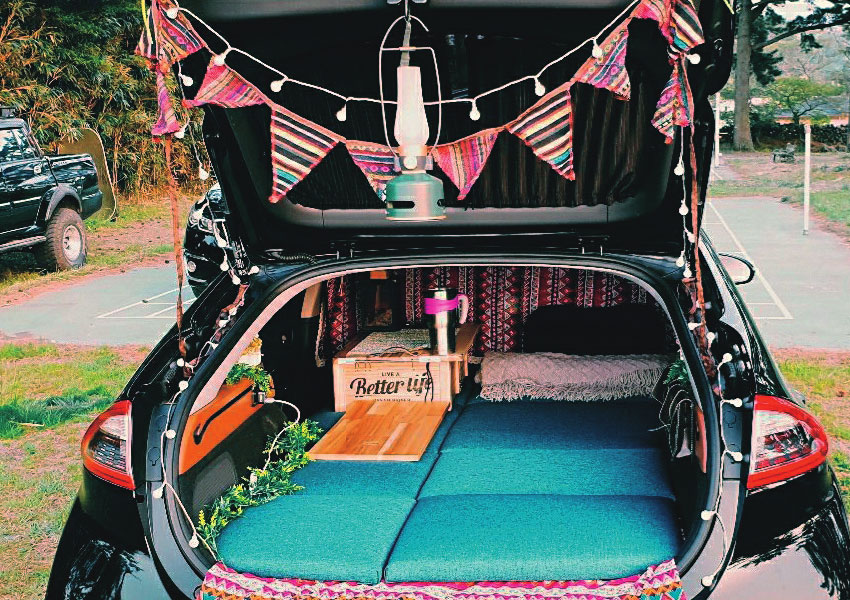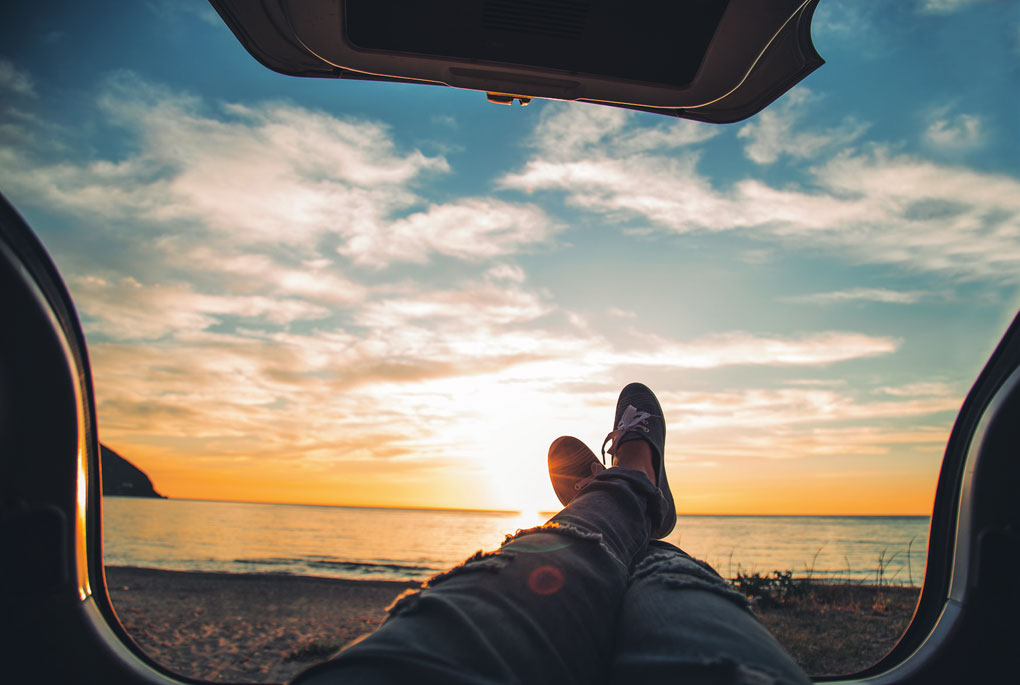Car camping is a popular leisure activity that allows for cheap, spontaneous getaways so long as you are willing to sleep in your vehicle. It is growing increasingly popular amid the COVID-19 pandemic and the need for social distancing.

A car camper stays by the side of Lake Chungju. Car camping allows for simple relaxation away from formal camping grounds, which often have a waiting list for permits. © Lee Jung-hyuk
“First, push the first-row bench seat forward as much as possible. Then, fold the second-row bench seat in the same direction,” instructs a YouTuber as he points to the inside of his sports utility vehicle. In less than 30 seconds, he creates a new floor inside of the car. Next, he measures to make sure his mattress can fit. Two meters long and one meter wide. All set.
“Any man can feel comfortable in this space,” he says with a smile. “It can be cozy if you travel with your girlfriend.” This video, uploaded to YouTube in July 2019, had more than 100,000 views as of this October.
Car camping is to “bivouac in a car.” It’s a style of camping that involves only a few camping essentials, adjustments and a willingness to accept less comfort and fewer amenities. The approach isn’t only appealing to budget-minded travelers; others may appreciate how reservations and various preplanning tasks can be skipped.
Membership in Car Camping Club, Korea’s biggest online community of car campers, jumped from about 80,000 in late February to some 170,000 by early September.
The outbreak of COVID-19 may well have contributed to the two-fold increase in membership. Car camping helps people escape the emotional and mental stress of coping with the pandemic and being outdoors is conducive to social distancing. One female YouTuber has attracted more than 400,000 viewers with a single video on car camping. She said that for those who want to enjoy spending time alone, there’s nothing like the kind of leisure it provides.
Last March, as Korea was tightening its grip on COVID caseload and social distancing became the new norm, an episode of “I Live Alone,” a popular reality show on MBC TV, featured a young actor and a member of a boy band car camping at a seaside park. After the episode aired, “car camping” popped up on portal site lists of search keywords and postings with enthusiastic responses were uploaded to social media. Hundreds of thousands of results can be found if you search Instagram hashtags for “car camping.”

The inside of a sports utility vehicle outfitted to suit a car camper’s taste. A sleeping pad is essential. After that, the interior can be as austere or decorated as the camper wants. © Kim Nam-jun

SUVs are preferred for car camping because they have wide interior space. Owners of regular passenger cars may fold back their seats and tolerate a cozier fit. © gettyimages
Car campers can be on their way at the spur of the moment. They can park their car practically anywhere they want to linger, unbound by a formal camping ground or recreational forest. Plus, they don’t need any reservations.
Get Up and Go
Spontaneity and ease are the main features powering the growth of this car-oriented leisure culture. Car campers can be on their way at the spur of the moment. When their workweek ends on Friday, they can suddenly decide to drive to a scenic locale and enjoy fresh air the next morning.
They can park their car practically anywhere they want to linger, unbound by a formal camping ground or recreational forest. Plus, they don’t need any reservations.
Traditional camping with tents and an array of equipment hasn’t lost its appeal. But that means there’s also a long wait to get into a registered camping ground. Securing a time slot amid the high demand naturally requires the kind of planning and commitment that car campers avoid.
Most car campers prefer seaside or riverside parks installed with public restrooms. There are plenty of car camping sites with such facilities. But an increasing number of these public places have started to restrict access because of problems that can arise as a result of unrestricted camping and cooking. In some cases, many car campers have converged at the same time and damaged the environment.
There are also other drawbacks. For example, air mattresses aren’t as comfortable as standard mattresses, so car camping may not be ideal for sensitive sleepers. Another potential sleep-related problem is ensuring a flat surface. In 2020, regulators allowed passenger cars to be converted into camping vehicles, but it isn’t always easy to find a uniformly even surface. And, of course, car camping isn’t an attractive option for anyone who simply must start their day with a morning shower. Car campers also have to be prepared to cope with weather extremes as it can be risky to keep their air conditioner or heater on for a long time.
Consumer Market Niche
The car industry and outdoor equipment brands have the answers to mitigate these discomforts. SUVs, a longtime favorite for accommodating both passengers and equipment, are preferred because in addition to giving campers open space for sleeping, they provide protection from weather. But sales of pickup trucks have increased sharply, too. They rose from some 22,000 units in 2017 to about 42,000 in 2018, according to a report by the Korea Automobile Manufacturers Association. In the same two-year period, the value of the domestic camping industry grew around 30 percent from 2 trillion won to 2.6 trillion won, or about US$1.8 billion to US$2.3 billion, according to the Korea Agency of Camping and Outdoor Activity.
Analysis of sales data for the June-July period by online shopping mall SSG.com shows that sales of car camping tents (which can easily be attached to the back of any vehicle) and air mattresses soared a whopping 664 percent and 90 percent, respectively, from two months earlier. Sales of iceboxes, another essential camping accessory, increased more than tenfold. According to superstore Lotte Mart, sales of camping chairs and tables rose 103.7 percent, sleeping bags and air mattresses 37.6 percent, tents 55.4 percent, and camping cooking utensils 75.5 percent during the same period.
Of course, the amount and quality of equipment required comes down to what individual campers need or want. Much depends on the desired level of comfort. Some car campers simply need a few prepared meals and a bottle of wine to declare that they’re ready to go. Still, there’s always the temptation to upgrade for a little more convenience on the next outing. One male YouTuber admitted that he quit going on car camping trips just because of his excessive passion for high-end equipment.